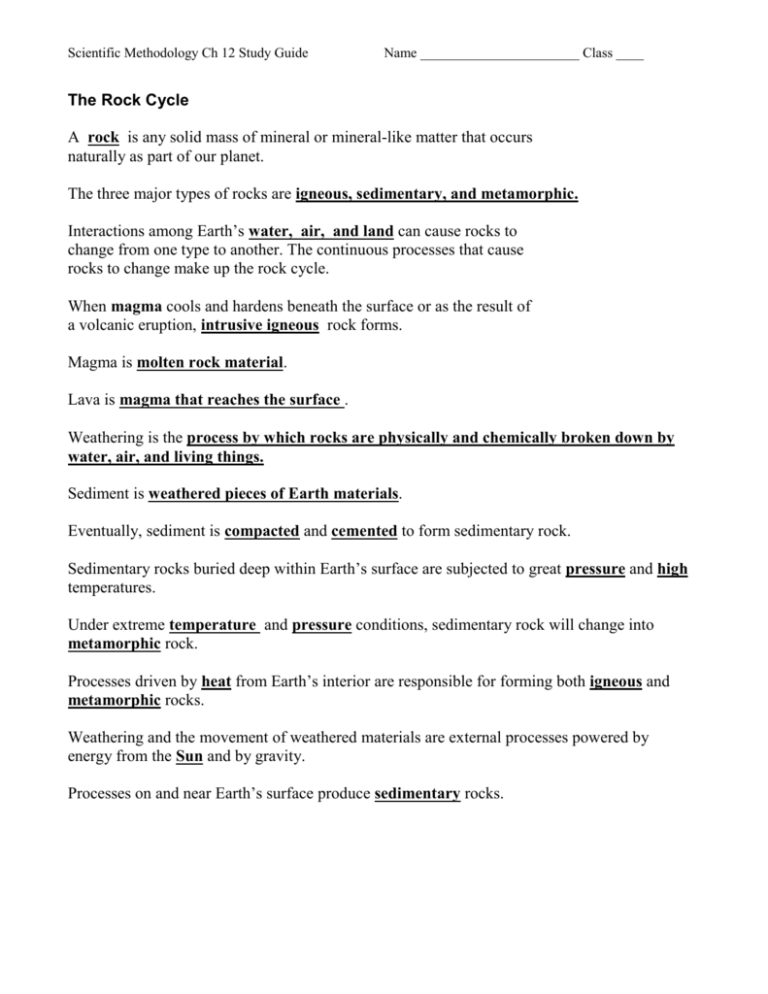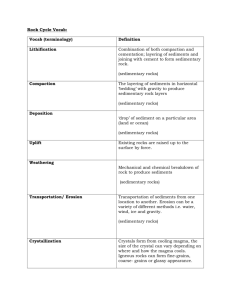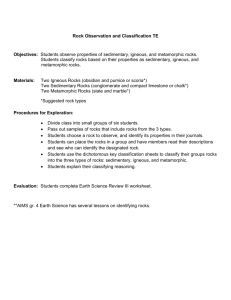Rocks study guide
advertisement

Scientific Methodology Ch 12 Study Guide Name _______________________ Class ____ The Rock Cycle A rock is any solid mass of mineral or mineral-like matter that occurs naturally as part of our planet. The three major types of rocks are igneous, sedimentary, and metamorphic. Interactions among Earth’s water, air, and land can cause rocks to change from one type to another. The continuous processes that cause rocks to change make up the rock cycle. When magma cools and hardens beneath the surface or as the result of a volcanic eruption, intrusive igneous rock forms. Magma is molten rock material. Lava is magma that reaches the surface . Weathering is the process by which rocks are physically and chemically broken down by water, air, and living things. Sediment is weathered pieces of Earth materials. Eventually, sediment is compacted and cemented to form sedimentary rock. Sedimentary rocks buried deep within Earth’s surface are subjected to great pressure and high temperatures. Under extreme temperature and pressure conditions, sedimentary rock will change into metamorphic rock. Processes driven by heat from Earth’s interior are responsible for forming both igneous and metamorphic rocks. Weathering and the movement of weathered materials are external processes powered by energy from the Sun and by gravity. Processes on and near Earth’s surface produce sedimentary rocks. Scientific Methodology Ch 12 Study Guide Name _______________________ Class ____ Igneous Rocks Rocks that form when magma hardens beneath Earth’s surface are called intrusive igneous rocks. When lava hardens, the rocks that form are called extrusive igneous rocks. Composition and texture are two characteristics used to classify igneous rocks. Texture is determined by the size, shape, and the arrangement of interlocking crystals. Composition is determined by the proportions of light and dark minerals. Slow cooling results in the formation of large crystals. Rapid cooling of magma or lava results in rocks with small, interconnected mineral grains. Porphyritic texture occurs in rocks with different-size minerals that cool at different rates. Granitic composition occurs when igneous rocks contain mostly quartz and feldspar. Basaltic composition occurs when rocks contain many dark silicate materials. Andesitic composition occurs in rocks with a combination of granitic and basaltic rocks. Ultramafic rocks are composed almost entirely of dark silicate minerals. Sedimentary Rocks Erosion involves weathering and the removal of rock. When an agent of erosion—water, wind, ice, or gravity—loses energy, it drops the sediments. This process is called deposition. Sediments form when solids settle out of a fluid, such as water or air. Compaction and cementation change sediments into sedimentary rock. Compaction is a process that squeezes, or compacts, sediments. Cementation takes place when dissolved minerals are deposited in the tiny spaces among the sediments. Scientific Methodology Ch 12 Study Guide Name _______________________ Class ____ Just like igneous rocks, sedimentary rocks can be classified into two main groups according to the way they form. Clastic sedimentary rocks are made of weathered bits of rocks and minerals. The size of the sediments in clastic sedimentary rocks determines their grouping. Chemical sedimentary rocks form when dissolved minerals separate from water solutions. The many unique features of sedimentary rocks are clues to how, when, and where the rocks formed. The oldest layers in sedimentary rock formations are at the bottom. Fossils are found in sedimentary rocks and can provide much information about the rocks that contain them. Metamorphic Rocks Most metamorphic changes occur at elevated temperatures and pressure. These conditions are found a few kilometers below Earth’s surface and extend into the upper mantle. Metamorphism refers to the changes in mineral composition and texture of a rock subjected to high temperature and pressure within Earth. During contact metamorphism, hot magma moves into rock. This usually results in minor changes in rocks. Regional metamorphism results in large-scale deformation and high grade metamorphism. This usually results in intense changes such as mountain building. The agents of metamorphism are heat, pressure, and hydrothermal solutions. Hydrothermal solutions occur when hot, water-based solutions escape from a mass of magma. The texture of metamorphic rocks can be foliated or nonfoliated. Foliated metamorphic rocks have a layered or banded appearance. Nonfoliated metamorphic rocks do not have a banded texture and usually contain only one mineral.








